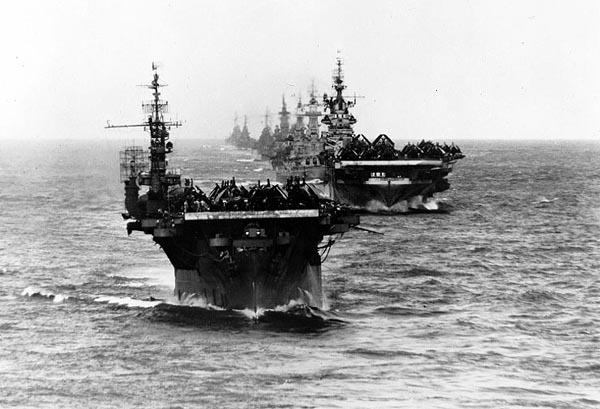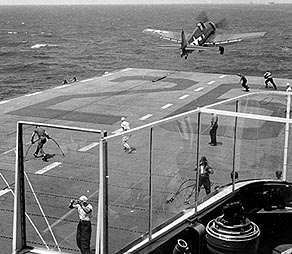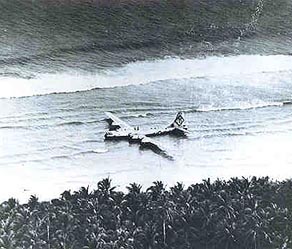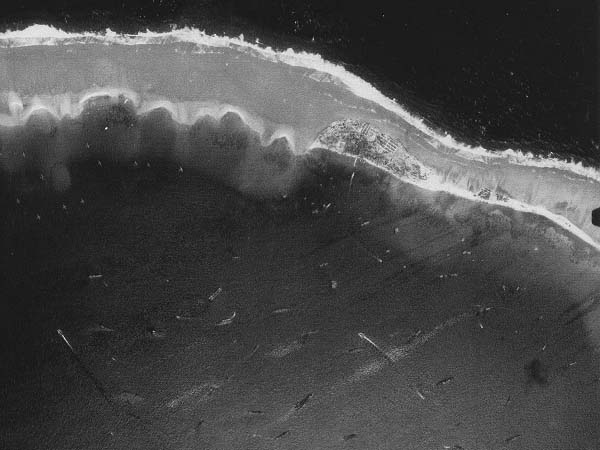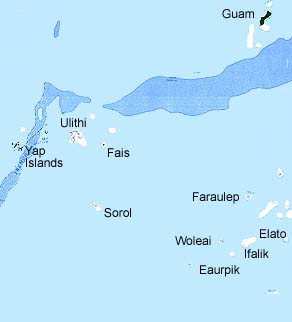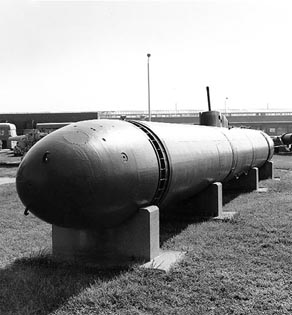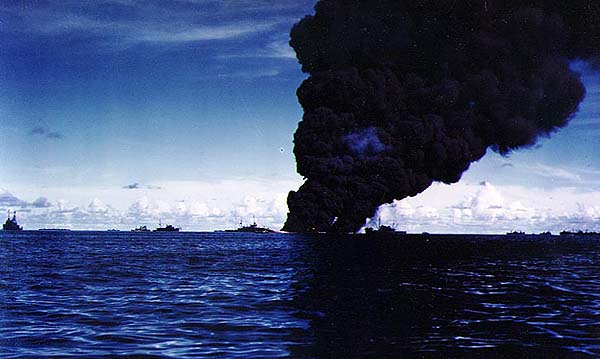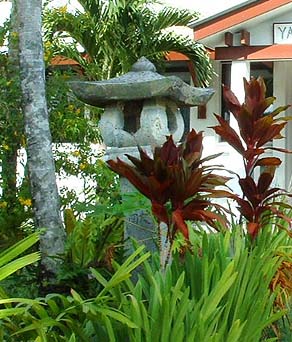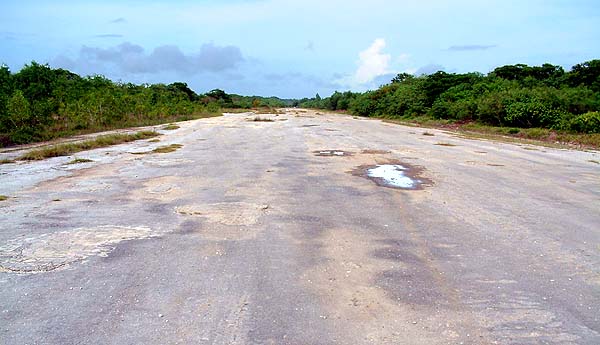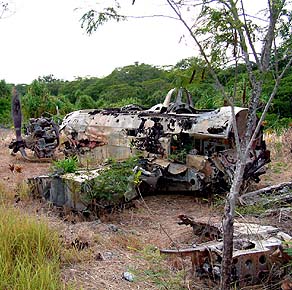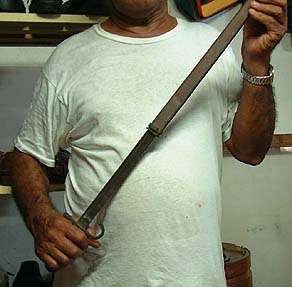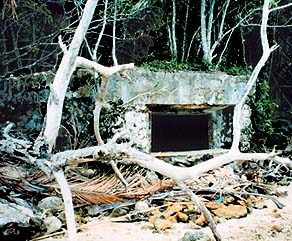 |
 |
 |
|||||
|
|
|
|
|
|
|
|
|
|
|
|||||||
| |
|
|
|
“Sometime the Japanese brought their full fleet inside the lagoon,” Manuel recalls, “and after about a couple of months they’d move away and come back again. There were air raids here, before the invasion. That first U.S. air raid was March to September, almost every day. They came from Guam dropping bombs and firing guns and everything. Oh, it was terrible. We were all scared. I thought I was going to die."
|
||
|
|
||
“When the American planes arrived, I was still young," Flomina Yetang says. "I was out the end of Asor—I had gone there to pick copra—and when the planes arrived, I started running back here. That’s when everybody started running around, all confused, because some of the planes started circling the islands and started shooting. "I went to Mogmog with my husband during the night, on the canoe with one or two other persons. When we started leaving this island, the plane was going over us. We thought the plane was going to shoot us, but the plane was shooting at the Japanese ships at the dock here. “Then we went to Mogmog, and when we got to Mogmog, everybody on Mogmog was in hiding. And so the person that brought us there, he started yelling around for people to come and help and help us put the canoe up. The whole island was in darkness. But finally people started coming down and helped.” A man from Asor who was married to the daughter of the Mogmog chief was killed in this attack. Click here to read about it .
|
|
|
"I was in Ulithi in1944, March 31st, when the first U.S. military airplane came and bombed the islands," Alphonso remarks. "It was between 10 and 11 o’clock in the morning, and the only Japanese on Ulithi were some weather observers on Asor. At that time, there was a Japanese military ship which brought their supplies, and it was anchored in front. "Luckily I was on Mogmog because they didn’t bomb or shoot at Mogmog at that time. They concentrated on Falalop and Asor mostly, because that’s where the Japanese houses were. And the watchtower on the Asor. "But if they had shot at Mogmog at that time, many people would have been injured and killed because it was like a movie to us. Everybody went down in front of the island, and we watched the plane goes down there. They were dive-bombing the ship." Click here to read about casualties on the ship.
|
|
|
|
|
"Because we had heard about a U.S. submarine that had been shooting at Fais, we thought it was a U.S. submarine that was trying to shoot at Asor, and that those planes were Japanese planes that tried to attack. So it was sort of like the Japanese movies we had seen, so everyone was going, ‘Hey! Hey! Hey!’ We thought these were Japanese planes , but it wasn’t, it was Japanese on the ground, and the U.S. in the air. Then finally about 11 or 12 o’clock, they went away." "In the afternoon, I think about 5:00 o’clock, that’s when people started moving away from Asor. Some of them went up to Falalop and some of them came to Mogmog. And my brother and those people he worked with from Mogmog came to Mogmog. "There was a hole through the Japanese ship. So they started the ship and they grounded it near Yeweech island, between Sohl’oay and Asor. They took their dead and buried them on that island with the ironwood trees. And then they plugged up their ship and pulled out again and went to Asor and picked up all those weather observers there. One of them was injured. He had been inside a bunker, when they bombed the place, a piece of coconut tree they had put on top of the bunker to cover it broke into pieces, and one piece was skewered through his side. It didn’t go all the way through, but it broke his ribs, so they had to take him down to Yap."
|
||
| |
||
“I guess two or three months after that, a Japanese ship came from Yap and went to Asor and pumped up some fuel. I was still very young then, but according to the story I heard, they said they were going to bring some seaplanes to Ulithi. But nothing happened. The only thing that happened is when the American plane came back and they shot the fuel, and that’s Boom!" “The Japanese built a seaplane ramp on Woleai,” Mariano adds, “because the lagoon is more calm than Ulithi lagoon. So now the Japanese could utilize their sea planes, but not here. There are so many outlets in the reef, channels and such, so the water is always moving. Unlike Woleai where it is much calmer."
|
|
|
“When a Japanese suicide sub—Kaiten—sank an American oiler, there were a few planes that came overhead,” Mariano says, “but they were blown out of the sky automatically. That time, the Americans were shadowed here. "By the time the Americans landed, the Japanese had left. There were only one or two here, and these weren’t military personnel. They were like company men or something. On Fais, however, there were still a couple of soldiers left and they tried to resist the U.S. invasion.” “The local houses, some of them burned up during the War,” Hosay remarks. “During the war, people made hiding places, bunkers. They dug the ground, cut coconut trees, put on the logs over and covered up with leaves and put the dirt back on it. There was a opening just to get in and out."
|
|
|
|
|
“But us, we moved down to Ptongeras. Three families, we stayed in Ptongeras during the War. When the Americans got to Ptongeras, one of these old men spoke pidgin English. Not very well but he could understand.” Click here to read about the landing of Americans on Potoangroas.
|
||
|
|
||
“The Japanese had taken me to Fais island,” Barney relates. “So I stayed there one year, and then they moved us to Yap. We worked with the Japanese soldiers, doing labor. Then later, during the War, no more supplies came from Japan. So we planted sweet potato almost all over Yap. Japanese soldiers plus Koreans and Okinawans and natives. It’s only job we had: plant something, and fishing. Night time, day time. Hard work. We lived in the bushes, in the boonies. “The bombing raids started from Colonia, Yap and they went this way, and they went that way, dropping bombs from B-29s. The planes were too high for the Japanese guns to reach them. I was scared, because it’s the first time I saw and I heard bombs blow. Many Japanese died. But us, not very many, because we were in the boonies."
|
|
|
“There was a Shinto shrine in Yap,” Chief Yatch recalls. “We used to go there, I think every beginning of the month, and pray for the Japanese to win the war. I was in Grade One, and on December 8 in our school we heard that we attacked Pearl Harbor. So we were very happy, singing around and going around Colonia, celebrating our victory. “I was in school on Yap when the war came to us: American fighters. And after that, those B-25 and B-17, they came every day for I don’t know how long, until they got Ulithi. Once they got to Ulithi, the big planes stopped and fighters came from Ulithi to Yap every day until the War is ended. “The Americans made this runway on Falalop, and used this island for a Marine air base. And after that they came over to Yap daily for bombing. And Woleai too. The Japanese had a big Naval air base in Woleai atoll."
|
|
|
|
|
"They dropped bombs in Yap and Woleai every day until the war ended. There was a Japanese air field in Yap. Four hundred workable airplanes, fighters, so these American and Japanese had these dog-fights in the sky. It was beautiful. I was very scared. Sometimes I was really scared. "
|
||
|
|
||
“In Yap the Japanese surrendered," Mariano says. "I guess, when the U.S. landed in Yap, word was already sent over and also by means of pamphlets dropped over in Yap, all over the island, telling them that the war was over. And by that time they just couldn’t resist, because all their food supplies were cut, and even the islanders were killing the Japanese soldiers because they began to steal every thing that they could. "There were cases that I heard of. The Japanese would think that they owned someone's garden. But that local individual is also suffering. He has to look after his family also. And one thing would lead to another…. People don’t really talk about it, but it was because of hunger."
|
|
|
"Before, when the fighting was still going on, they would just come and tell this poor family, ‘you have to provide this for the military. You’re going to have to do this, you must do this. You have to climb the coconut tree for the soldiers.’ But then it was turning, getting closer to the end of the war, and that’s when the locals realized that, ‘oh they’re going to lose.’ And that’s when the Japanese started coming up against them. "But before, no way; they have to do whatever they say. They forced them to make huge gardens on the hillsides, and they were for the military use. One hillside was dug by the islanders, especially those from these small islands who were in Yap working for the military. They were forced laborers."
|
|
|
|
"As they were getting toward the end, and they knew that they were not going to win the war, they had all these people dig into the side of a hill. A huge hole, mainly for them. Once the Americans landed, they were going to herd everybody to in this hole and just blow it down, close it on them. So they were digging their own grave."
|
||
|
|
||
“Yap was completely fortified by the Japanese,” Alphonso says. “Many thousands of Japanese were here in Yap. One of my brothers also was in Yap working with them. The U. S. military was going to invade Yap, but our former chief, he’s the one who begged them not to, according to what I heard. And they said, ‘Why?’ and he said ‘If you invade Yap you’re going to kill all our people.’ "You see, just before the attack, the Japanese came and got all the young men from all the Outer Islands. They took them down to Yap to work on the airport there. So, he’s the one who begged them not to."
|
|
|
"Then the Americans said, ‘Why don’t we take someone else and drop them, to swim ashore to separate those people?’ "My uncle, a chief who just passed away, suggested that somehow this thing wouldn’t work out. Later I heard from the people who were on Yap, when they came back, that they won’t have had any chance. Because all those people were tagged like a dogs, and if they caught you without a tag, they’d shoot you on the spot. And they were patrolling the whole island at that time. So it was lucky, because they wouldn’t have had any chance."
|
|
|
|
| "So the Americans just surrounded the island and didn’t invade, until the War was over."
|
||
|
|
||
|
|
|
|
|
|

|
| Ulithi Home | Map Library | Site Map | Pacific Worlds Home |
|
|
|
|

|
|
|
||
|
Copyright 2003 Pacific Worlds & Associates • Usage Policy • Webmaster |
